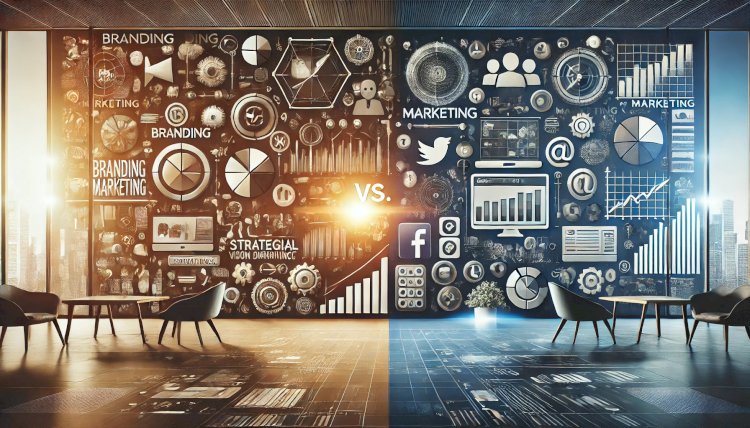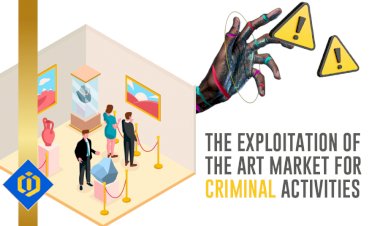Branding vs. Marketing: Key Differences and Their Role in Sustained Business Success

This article is originally published on A Land and written by Dr. Pooyan Ghamari, Swiss Visionary
You can also listen to a podcast about this article on ALand Podcast: Reef Luxury Real Estate
The Strategic Challenge for Businesses
In today’s competitive landscape, business leaders recognize the importance of visibility and engagement. Yet, many fail to differentiate between branding and marketing—two critical components of a company’s success. The common misconception that these are interchangeable often leads to short-term wins but long-term instability.
The truth is straightforward: marketing grabs attention, while branding fosters loyalty. Marketing acts as the tactical means to achieve visibility, whereas branding is the foundation that builds trust and recognition. Without strong branding, marketing efforts are fleeting. Without marketing, even the best brands remain hidden.
This article explores the distinctions between branding and marketing, common pitfalls businesses encounter, and how integrating both can drive sustainable growth, trust, and resilience.
Comparing Branding and Marketing: Understanding Their Unique Roles
| Branding | Marketing |
|---|---|
| Why? (Mission and Purpose) | How? (Execution and Strategy) |
| Identity (Who You Are) | Strategy (How You Reach Customers) |
| Long-Term Loyalty (Trust) | Short-Term Engagement (Awareness) |
| Broad (Company-wide Influence) | Targeted (Campaign-Specific Focus) |
| Being (Values and Perception) | Doing (Promotions and Lead Generation) |
Branding Defines Identity, Marketing Amplifies It
Branding is the core identity of your business—it represents its values, mission, and the emotional connection it creates with customers. It defines how your business is perceived and the trust it inspires.
Marketing, on the other hand, is a collection of strategies and tools designed to communicate that identity, raise awareness, and drive sales. Marketing is dynamic, adapting to consumer trends and market demands, while branding remains the constant foundation.
The Importance of Branding: Why It’s Essential for Business Longevity
1. Branding Builds Reputation and Differentiates Your Business
A strong brand is one of the most valuable assets a business can have. It explains why companies like Apple, Tesla, and Rolex command respect, loyalty, and premium pricing.
The Economic Value of Branding:
Studies show that leading global brands like Apple and Amazon derive over 60% of their value from branding. Strong branding delivers:
- A sense of exclusivity and quality
- Higher customer lifetime value (CLV)
- The ability to avoid price wars through premium pricing
- Enhanced investor confidence and market performance
2. Branding Reduces the Cost of Customer Acquisition
Without a strong brand, businesses are forced to rely heavily on expensive advertising and aggressive sales tactics. Over time, this becomes unsustainable. Effective branding:
- Reduces the reliance on paid ads
- Encourages organic growth through referrals
- Builds lasting, authentic relationships with customers
Businesses that neglect branding often find themselves vulnerable to market pressures and economic downturns.
Why Marketing Matters: Branding Needs Marketing to Succeed
1. Marketing Drives Awareness and Sales
While branding lays the foundation, marketing ensures people know about your business. Without effective marketing, even a strong brand struggles to gain traction.
2. Marketing Evolves with Consumer Behavior
Marketing adapts to emerging trends and platforms, including:
- Social media advertising (Meta, TikTok, LinkedIn, X)
- Search engine optimization (SEO)
- Influencer collaborations and partnerships
- AI-driven personalization and retargeting
Companies that fail to adopt modern marketing strategies risk losing relevance and visibility, even with a strong brand.
Six Common Branding and Marketing Mistakes
-
Thinking Branding is Just a Logo
Branding goes beyond logos and visual design—it’s about the perception and trust your business creates.
Solution: Develop a clear mission, story, and values that resonate with your audience. -
Relying on Marketing Without a Clear Brand Identity
Heavy investment in marketing without a defined brand leads to low retention and high churn.
Solution: Focus on building a strong brand identity before launching large-scale marketing campaigns. -
Prioritizing Short-Term Sales Over Long-Term Loyalty
Flashy promotions may drive quick sales, but they don’t create lasting customer relationships.
Solution: Build trust and loyalty through meaningful brand experiences. -
Inconsistent Messaging Across Channels
Disjointed branding confuses customers and weakens trust.
Solution: Maintain consistency in tone, visuals, and messaging across all platforms. -
Ignoring Emotional Connections with Customers
Customers value experiences and trust over products.
Solution: Create stories and experiences that emotionally connect with your audience. -
Overlooking Data-Driven Marketing Strategies
Ignoring analytics and personalization limits the effectiveness of marketing efforts.
Solution: Use AI and data tools to tailor campaigns and optimize performance.
How to Integrate Branding and Marketing for Maximum Impact
- Develop a Strong Brand Identity – Clearly define your mission, vision, and values.
- Ensure Consistency – Use a unified tone, design, and messaging across all platforms.
- Leverage Technology – Utilize AI and marketing automation to personalize campaigns at scale.
- Optimize Your Digital Presence – Invest in SEO and social media strategies to improve visibility.
- Align Branding with Business Goals – Ensure that your branding reflects your long-term strategy and customer experience.
Final Thoughts: Branding and Marketing Are Complementary, Not Competing
Marketing creates awareness, but branding builds relationships. The most successful companies don’t just sell products—they create a sense of identity and community for their customers.
In a world where consumer loyalty is increasingly hard to earn, businesses that master the synergy between branding and marketing will gain a competitive edge, attract premium investors, and achieve long-term success.
If you’re ready to take your brand and marketing to the next level, explore these industry-leading solutions:
- branding.a.land– Expert consultancy for long-term brand strategy.
- i.a.land– AI-driven marketing optimization for smarter business growth.
- a.land– A premier real estate portal for digital real estate investments and market intelligence.
By leveraging the right branding and marketing strategies, businesses can thrive in both short-term sales and long-term loyalty.
About the Author
Dr. Pooyan Ghamari is a Swiss Economist, Entrepreneur, and Founder of A.Land, specializing in global economic strategies, real estate investments, and financial innovation. His expertise spans AI-driven marketing, branding, and economic development in international markets.
Elevate Your Brand with Smart Solutions
At ALand, we merge technology with strategy to drive real results. Whether you need cutting-edge software, AI-powered marketing, or branding expertise, we have the tools to transform your business. Explore i.a.land for intelligent software applications and digital marketing solutions, or visit branding.a.land for expert branding consultancy and in-depth marketing audits. Ready to scale your brand? Let’s ignite your brilliance today!
FAQ's
Why do many businesses struggle to differentiate branding from marketing?
Many businesses mistake branding for just a logo, tagline, or color scheme, whereas branding is about building trust, perception, and emotional connection over time. Marketing, on the other hand, is the strategic promotion of that brand to gain visibility and sales. To avoid this confusion, businesses must first establish a clear brand identity, mission, and values before launching marketing campaigns. A strong brand acts as a foundation, while marketing is the vehicle to amplify that brand to the world.
Can a business survive with strong branding but weak marketing?
A strong brand helps retain customers and build loyalty, but without effective marketing, it may struggle to gain visibility and attract new customers. For example, Tesla has a powerful brand identity, but its marketing is strategic and unconventional, leveraging word-of-mouth, PR, and product-led storytelling. A business can survive on branding alone for a while, but to scale and grow, marketing must be integrated to reach a broader audience.
What is the biggest branding mistake companies make?
One of the biggest mistakes is inconsistent branding across platforms. When a company’s messaging, design, and customer experience differ across social media, websites, products, and offline interactions, it confuses customers and weakens trust. Solution: A company must maintain a cohesive brand identity, ensuring that its visuals, tone of voice, and core values remain consistent across all touchpoints.
How can businesses measure branding success, beyond just sales?
Branding success is not measured by immediate sales but by long-term impact. Key metrics include: • Brand awareness – How well your audience recognizes your brand. • Customer loyalty & retention – Do customers keep coming back? • Net Promoter Score (NPS) – How likely are customers to recommend your brand? • Emotional connection – Does your brand create strong engagement and advocacy? Great branding increases lifetime customer value (LTV), meaning customers stay longer, spend more, and refer others.
Why do some businesses spend millions on marketing but still fail?
Because they market a weak brand. Many businesses focus on short-term sales-driven marketing campaigns without building a memorable, trustworthy, and differentiated brand. Example: If two companies sell identical smartphones, but one is Apple and the other is an unknown brand, Apple will win customer trust every time—even without aggressive advertising. Solution: Businesses should invest in branding first, then amplify it with smart, data-driven marketing strategies.
Is it possible to build a strong brand without spending on traditional marketing?
Yes, if branding is powerful enough to create organic growth. Some brands, like Tesla, spend little on traditional advertising, but their branding is so strong that they rely on: • Word-of-mouth marketing • PR and media exposure • Community engagement and exclusivity However, not all businesses can rely on this strategy. Startups and mid-sized companies must combine branding with strategic marketing, especially in competitive industries.
Should startups focus more on branding or marketing in the beginning?
Startups should focus on branding first, ensuring that they have a clear mission, vision, and unique value proposition (UVP) before aggressively marketing. A strong startup brand should define: • What problem it solves • Why it’s different from competitors • How it connects with customers emotionally Once this foundation is built, marketing efforts become more effective, ensuring that campaigns attract the right customers with the right message.
How can businesses adapt branding strategies in a fast-changing digital economy?
Branding must be flexible and adaptable while maintaining core identity. Some key strategies include: • Personalization & AI-driven branding – Using AI-powered platforms like i.a.land to analyze customer behavior. • Real-time engagement on social media – Brands need to engage in conversations, not just broadcast messages. • Sustainability & purpose-driven branding – Consumers now expect brands to be socially responsible and eco-conscious. Successful brands evolve with technology while staying true to their core values.
What is the future of branding and marketing in an AI-driven world?
and automation are reshaping branding and marketing in three major ways: 1. Hyper-Personalization – AI-driven marketing tools, like those on i.a.land, can create tailored content, ads, and recommendations for individual users. 2. Predictive Analytics – AI can forecast consumer behavior trends, helping businesses refine branding strategies. 3. Automation & Chatbots – AI-powered virtual brand assistants will handle customer interactions, keeping brand messaging consistent and responsive. Key takeaway: Businesses that embrace AI-powered branding and marketing solutions will have a competitive edge in the digital economy.
How can businesses integrate branding and marketing for maximum impact?
A business must align branding (identity, mission, and values) with marketing (visibility, engagement, and sales tactics) in a cohesive strategy. 5-Step Framework for Integration: 1. Develop a Strong Brand Identity – Define the mission, values, and messaging that set you apart. 2. Create Consistent Branding Across Channels – Ensure that your logo, tone, and visuals align across all platforms. 3. Leverage Data-Driven Marketing – Use AI-powered tools like i.a.land to refine targeting and engagement. 4. Invest in Brand Storytelling – Move beyond ads and tell a compelling brand story that builds emotional trust. 5. Measure & Adapt – Continuously track branding and marketing KPIs to refine strategies. Businesses that balance branding with smart, evolving marketing will dominate their industries. Final Thought: Branding and Marketing Must Work Together Many businesses either focus too much on short-term marketing or invest in branding without the right promotional strategy. The most successful companies align both.

 content-team
content-team 


















